
- Search forums
Follow along with the video below to see how to install our site as a web app on your home screen.
Note: This feature may not be available in some browsers.
- Secret (Unbuilt) Projects
- Secret Naval Projects

Stealth Trimaran Aircraft Carrier (STAC)
- Thread starter Triton
- Start date 13 March 2009
Donald McKelvy
- 13 March 2009
The 40,000 ton Stealth Trimaran Aircraft Carrier (STAC) could operate an air wing of up to 55 aircraft using both ski-jump for STOVL aircraft and 450ft (140m) long diagonal deck for launching CTOL aircraft. Anyone have additional concept art or better scans of the concept art attached for the STAC?
Attachments
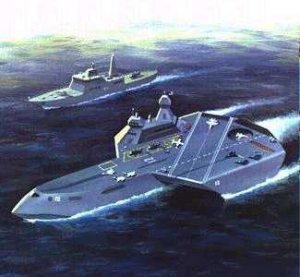
cluttonfred
Access: top secret.
I don't think I've ever seen a carrier flight deck angled so far off the centerline before. Seems a bit much....
ACCESS: Confidential
Just got around to converting the PDFs on My Avpro CDs to jpeg so here's the pics in the original size. And that cross wind is going to a b$#$^
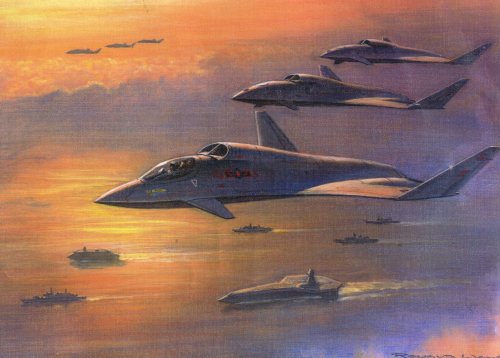
Cheers dragon72 . ;D ;D You wouldn't have anymore images you would be willing to share from the Avpro CDs?
Charles Gray
Access: restricted.
I was told that this AVPRO apparently was a company that never actually produced anything other than CD's and brochures (as opposed to the other AVPRO), so i'm rather dubious about the feasiblity of their design.
Charles Gray said: I was told that this AVPRO apparently was a company that never actually produced anything other than CD's and brochures (as opposed to the other AVPRO), so i'm rather dubious about the feasiblity of their design. Click to expand...
- 14 March 2009
I've seen pictures that might be a post CVX carrier that were trimaran, but never that design. And to be honest, "Interest" often seems to mean "someone somewhere came up with an artist conception of what it might look like." I'm not aware of any sign that the navy ever seriously considered a trimaran design for a post CVX carrier.
Thanks for the images, dragon72, these are by some way the clearest AVPRO scans I've seen. Triton mentioned "Warplanes of the Future", and "X-Planes" by the same authors is in my local library; does the CD offer much more in the way of images?
ACCESS: Above Top Secret
Avpro is a conceptual design and research company committed to design excellence, and the advancement of aerospace and defence technology. The company works closely with the UK aerospace and defence industry, and has an excellent working relationship with the UK Defence Evaluations and Research Agency (DERA). These links enable Avpro to offer a custom design service for air, sea and land platforms to customer's requirements and specifications. The company's conceptual design portfolio ranges from the EXINT Pod rescue system, conceived for the recovery of downed aircrew using the Harrier vertical take off and landing aircraft and Apache helicopter, to the radical stealth trimaran aircraft carrier (STAC) designed to outperform all current aircraft carriers in such parameters as speed, stability, safety and survivability. Avpro is justifiably proud of its association with the UK armed forces and can offer other governments impartial and professional advice in respect of equipment and military capabilities. The company can also provide direct support to military commanders in developing concepts of operation and tactics for existing and planned forces. In today's uncertain world Avpro is committed to providing highly innovative concepts which keep defence capabilities ahead of any adversary. Click to expand...
All hail the God of Frustration!!!
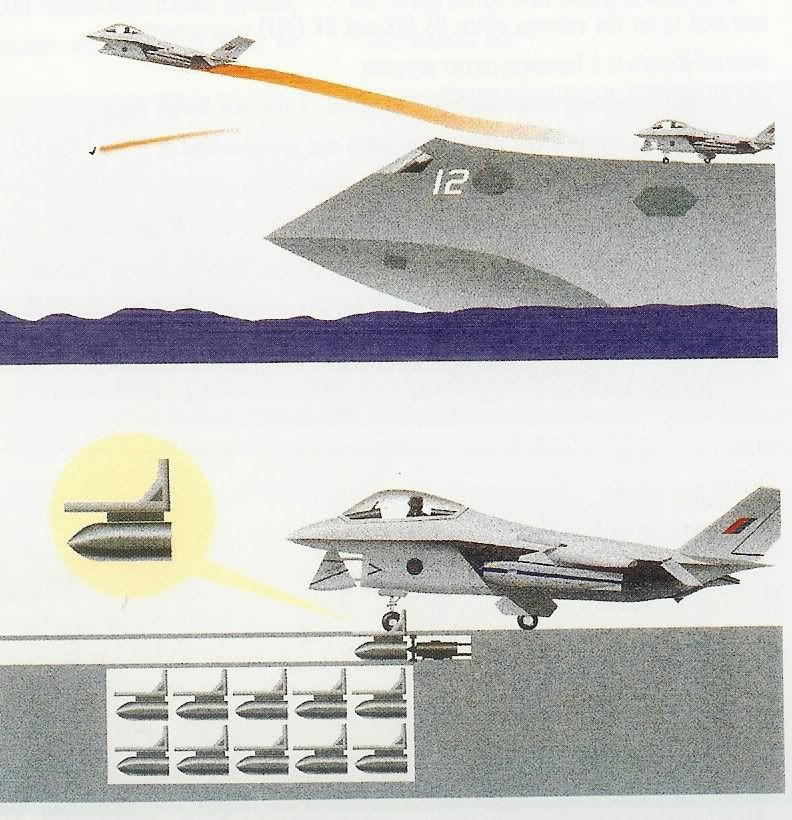
GTX said: They were around in the late '90s. They also set up a USA based arm if I remember correctly. They vanished though around 2001. Apart from the EXINT pod I don't believe anything else came close to the hardware stage. They did however have some very interesting concepts - my favourites were the Proteus Modular UCAV/Cruise Missile; the Titan large Stopped rotor transport, and some of their UCAV designs. One interesting aspect of the STAC was the proposed launch system - instead of a steam catapult, it was proposed to use a cartridge based launch system - see pic: Regards, Greg Click to expand...
If you look at the STAC drawings you will see that it was far from being "yet another light carrier concept." Regards, Greg
- 15 March 2009
Merv_P said: Thanks for the images, dragon72, these are by some way the clearest AVPRO scans I've seen. Triton mentioned "Warplanes of the Future", and "X-Planes" by the same authors is in my local library; does the CD offer much more in the way of images? Click to expand...
GTX said: One interesting aspect of the STAC was the proposed launch system - instead of a steam catapult, it was proposed to use a cartridge based launch system Click to expand...
Demon Lord Razgriz
Is there any stats on this carrier? Like the measurements of it.
- 16 March 2009
Using the planview, which shows several V-22 Ospreys, too, I would think, length is around 330m, maximum width about 122m ... ???
XP67_Moonbat
I presume that because the ship doesn't have a funnel it is nuclear powered?
hole in the ground
Access: secret.
- 17 March 2009
possibly the funnels vent into the space between hulls? reducing IR signiture?
- 31 March 2009
Is there anymore pics of this carrier, perferably high quaility & large. I'm trying to draw it Shipbucket style and those patches on the side of the main hull is really driving me crazy trying to figure out what the heck they are. Oh, and on that last pic Dragon posted, does anybody have any good pics of those fighters?
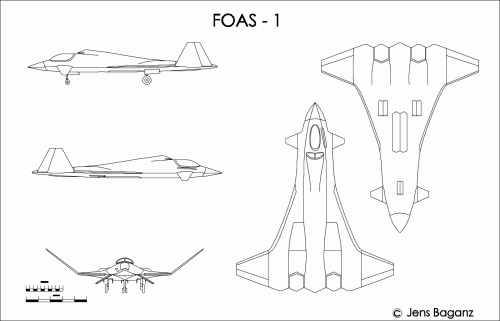
ACCESS: USAP
"Shouldn't that AvPro stuff go in the Fantasy section?" Well, some of them are quite near to those from the movie "Stealth", I think ! But as was pointed out in another thread, judging this company seems to be a little bit difficult. At least, they had one or two concepts, that looked quite real (exint pod and this modular cruise missile).
Jemiba said: "Shouldn't that AvPro stuff go in the Fantasy section?" Well, some of them are quite near to those from the movie "Stealth", I think ! But as was pointed out in another thread, judging this company seems to be a little bit difficult. At least, they had one or two concepts, that looked quite real (exint pod and this modular cruise missile). Click to expand...
Oh, thank you Jemiba. Those pics are exactly what I wanted, now all I need is more pics & details on the carrier. ;D
sferrin said: Shouldn't that AvPro stuff go in the Fantasy section? Click to expand...
I see the truth in it.
Right but if it's just some made up design it's still a made up design. Click to expand...
Avpro had a distinctly fly by night feel to me. Their "Investor's Club" fundraising scheme from 2000/01 was quite possibly an illegal stock offering, which doesn't make me feel good about the credibility of their technical proposals. They were a step above the Stavattii (sp?) Aerospace folks, in that they apparently did produce some hardware on one project, but otherwise they looked very sketchy.
Lampshade111
- 9 April 2009
An interesting concept regardless of their credibility. Such a ship looks possible although it's layout would probably be a bit different.
I just picked up a copy of Warplanes of the Future (about $7 used). The section on the "Stealth Trimaran Aircraft Carrier" gives a few more details. The diagonal flight deck is said to be 450 ft (130m) long, which makes the overall length about 920 ft (280m). Displacement was reported as approximately 40,000 tonnes, with a capacity of 55 aircraft. As speculated, exhaust would vent between the center and sidehulls. Speed was to exceed 40 knots, but no other details of power levels or prime movers was mentioned. Launch arrangements are confused. In one place, it mentions an electromagnetic catapult on the port sidehull for launching aircraft like Typhoon, Rafale, and F/A-18E. However, measuring off the drawing shows this catapult track to be about 130 feet long, which is only half as much as a C-13-1 steam catapult. It's hard to imagine that an electromagnetic catapult could do the job in half the length, even with the smoother acceleration profile it offers over steam. Elsewhere, it mentions the projectile-based catapult, with drawings suggesting it would work along the angled ski-jump. The various dark spots along the hull seem to be phased array emitters of various unspecified sorts.
- 10 April 2009
TomS said: I just picked up a copy of Warplanes of the Future (about $7 used). The section on the "Stealth Trimaran Aircraft Carrier" gives a few more details. The diagonal flight deck is said to be 450 ft (130m) long, which makes the overall length about 920 ft (280m). Displacement was reported as approximately 40,000 tonnes, with a capacity of 55 aircraft. As speculated, exhaust would vent between the center and sidehulls. Speed was to exceed 40 knots, but no other details of power levels or prime movers was mentioned. Launch arrangements are confused. In one place, it mentions an electromagnetic catapult on the port sidehull for launching aircraft like Typhoon, Rafale, and F/A-18E. However, measuring off the drawing shows this catapult track to be about 130 feet long, which is only half as much as a C-13-1 steam catapult. It's hard to imagine that an electromagnetic catapult could do the job in half the length, even with the smoother acceleration profile it offers over steam. Elsewhere, it mentions the projectile-based catapult, with drawings suggesting it would work along the angled ski-jump. The various dark spots along the hull seem to be phased array emitters of various unspecified sorts. Click to expand...
Demon Lord Razgriz said: As for the projectile-based catapult, wouldn't it have been easier to just use an electromagnetic catapult? Cause the one on the Superman ride curves IIRC. So those dark spots are PESA/AESA radars? Weird place to put them... Click to expand...
- 17 February 2012
Model of AvPro Stealth Trimaran Aircraft Carrier (STAC) on display at Model Boat Convention 09 (unofficial). Source: http://www.shipmodels.info/mws_forum/viewtopic.php?f=12&t=44613
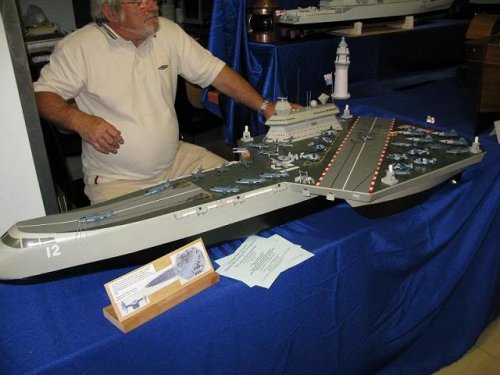
Is there nothing Avpro cannot do? Avpro designed Chuck Norris
Abraham Gubler
Triton said: Model of AvPro Stealth Trimaran Aircraft Carrier (STAC) on display at Model Boat Convention 09 (unofficial). Click to expand...
Abraham Gubler said: Great looking model but impossible to land an aircraft on. Click to expand...
- 18 February 2012
Triton said: Abraham Gubler said: Great looking model but impossible to land an aircraft on. Click to expand...
Triton said: Please elaborate, Abraham. Click to expand...
Thank you for the explanation, Abraham.

Similar threads
- Started by Mike Pryce
- 7 January 2007
- Replies: 55
- Started by overscan (PaulMM)
- 18 February 2008
- Started by A_Kid1234
- 17 November 2023
- Started by A Tentative Fleet Plan
- 27 March 2020
- Started by Brickmuppet
- 2 April 2008
- Replies: 123
Please donate to support the forum.
- This site uses cookies to help personalise content, tailor your experience and to keep you logged in if you register. By continuing to use this site, you are consenting to our use of cookies. Accept Learn more…
- svg]:fill-accent-900 [&>svg]:stroke-accent-900">
Meet China’s triple-hulled warship of the future
By Jeffrey Lin and P.W. Singer
Posted on Feb 23, 2017 9:44 PM EST
At the Dubai IDEX defense exposition, arms makers from around the world show off their latest wares. A notable debut at the recent 2017 show: a new, triple hulled Chinese warship design.
While showing off a model of the planned ship, China Shipbuilding Trading Company announced that it is aiming to start construction on a “trimaran” warship in 2018 for the People’s Liberation Army Navy (PLAN).
The Chinese navy already uses smaller trimaran ships for noncombat missions—think training torpedo recovery, search and rescue, and oceanographic research.
So what exactly are trimaran ships? The major distinction is they three hulls: one large, central one and two rearward smaller hulls connected by decks or girders. The design is used in the U.S. Navy’s new USS Independence subclass of the Littorial Combat Ship, and in fact the new Chinese ship looks very similar to that class.
The design means the ships have the advantage of a wider deck to operate more aircraft; this frigate design has a two-door hangar for helicopters and vertical take-off landing (VTOL) unmanned aircraft systems (UAS). Trimarans can also reach higher speeds, due to the reduced drag of having three hulls instead of a single wider one.
The Chinese trimaran frigate will be about 465 feet long, and has a beam of 105 feet and a weight of 2,450 tons. Interestingly, it may be the first Chinese warship to use an integrated electrical propulsion system (IEPS) to provide the power for driving its three pumpjets. It is unclear if the announced 2,450-ton displacement is full or light.
If we’re comparing the vessel to the USS Independence subclass of the Littorial Combat Ship, the latter is designed as a high-speed platform, with a top speed estimated at 50 knots, which is faster than the Chinese trimaran frigate’s announced 30-35-knot top speed. The Chinese trimaran frigate is far more heavily armed for conventional warfare; the American ship mounts only a 57mm cannon plus provisions for anti-ship missiles while the Chinese ship boasts the capacity for a 76mm cannon, anti-ship missiles, and vertical-launching system cells for carrying anti-ship, land attack cruise and anti-air missiles.
That being said, the USS Independence offers the flexibility of changing out mission modules (such as between anti-submarine and mine countermeasure missions). This flexibility may be overstated, however, as both trimaran designs have wide decks for intensive helicopter operations, and the Chinese version also appears to have ample cargo spaces to embark maritime special forces and unmanned surface and underwater systems.
If built, the trimaran frigate would provide the PLAN with a high-speed, heavily armed warship for littoral operations in the East and South China Seas. It would likely serve as a complement to smaller Type 022 stealth missile boats and Type 056 corvettes; fast enough to keep up with them, and provide them with area air defense and helicopter coverage. Its space for special operations and aviation units also makes it a candidate for Chinese special operations in the littoral environment, and its speed makes it a good rapid-response unit to regional emergencies. Finally, its large carrying capacity could come into play as a heavily armed mothership and command center for Chinese drones, unmanned boats, and submarine robots. If the PLAN does buy this trimaran frigate, it’ll have a warship that will open up new places in high paced 21st-century naval combat.
You may also be interested in:
China’s New Aircraft Carrier Hints at the Future of Its Navy
China’s Largest Surface Warship Takes Shape
New Chinese Catamaran Spy Ship Learns All About Japanese Water

China’s New Super Carrier: How It Compares To The US Navy’s Ford Class
A new aircraft carrier, currently under construction in shanghai, is the most visible sign of china's rapidly expanding navy. it is larger than china's current two carriers and differs in key aspects. but the natural comparison is to the u.s. navy's latest carriers, the ford class..
H I Sutton 02 Jul 2021
Aircraft carriers are a strategic priority for the world’s leading navies. Experienced players such as the Royal Navy, French Navy (Marine Nationale) and Indian Navy are all in the process of bringing in new carriers. And Japan, South Korea and likely other countries are all taking steps to join the club. But nowhere is the capability gathering steam as much as in China. The Chinese Navy (PLAN) has already commissioned two carriers based on the Russian Admiral Kutzenov class. But their third carrier, known as Type-003 , promises to take the PLAN to the next level.
Meanwhile the U.S. Navy, for decades the world leader in this technology, is also modernizing with a new class of super carrier. The first Ford Class ship, USS Gerald R. Ford (CVN-78) was commissioned in 2017. While it has suffered some teething problems it remains the largest and most modern carrier afloat.
The Type-003 is very close in size to the U.S. Navy’s carriers. And although the definition is vague, it seems fair to also describe it as a “super carrier”.
Fresh commercial satellite imagery from Kompsat, via Shadowbreak Inti., allows us to finally measure the size and layout of the Type-003. This permits a general high-level comparison to the Ford Class.
The imagery shows that it is approximately 320 meters (1,050 feet) long. This is about 13 meters (43 feet) shorter than the Ford Class. And it seems less than it sounds if you placed the two ships side by side.
The Chinese ship does have a narrower flight deck however, It’s width of about 73 meters (240 feet) is very similar to preceding Type-001 and Type-002 carriers. There may be logistical reasons for this, such as dry dock sizes. Or it may simply be that the Chinese planners were happy with the width of the current carriers.
Going Electromagnetic
The major step change over the current carriers however is in how aircraft will be launched. The new ship is CATOBAR (Catapult Assisted Take-Off But Arrested Recovery) while the first two are STOBAR (Short Take-Off But Arrested Recovery). Like the Ford Class, the Type-003 is believed to use an Electromagnetic Aircraft Launch System (EMALS) instead of a steam catapult. This should promise a faster launch rate. This is a cutting edge technology which has reportedly been less reliable so far on the Ford Class, although things are improving . Yet despite its challenges it is still seen as the way forward and we should not assume that the Chinese will have the same problems. For China it is pragmatic to go straight to EMALS and miss the steam catapult step.
The Type-003 has three catapults with two on the bow and one in a waist position. This is one fewer than the Ford Class which, like earlier American carriers with steam catapults, also has four.
Catapults, which are lacking on the current Chinese carriers, will allow new aircraft types to be carried. A new fixed-wing airborne early warning & control aircraft (AEW&C), the KJ-600, is expected to be aboard. This is, both in role and overall form, very similar to the E-2D Advanced Hawkeye. Other new aircraft are expected to include a carrier version of the FC-31 stealth fighter. A full-size mock-up of this has recently appeared at a test site in Wuhan. This will be generally equivalent of the Ford Classes’ F-35C Lightning-II. It has twin engines however, and possibly a larger internal weapons bay.
It is likely that this new plane will take some time to enter service so the Type-003 may start operations with a catapult capable version of the J-15 Flanker.
Finally here a clear image of the full carrier including its installed island. (Image via Tieba) and thanks a lot to @raz_liu pic.twitter.com/orewwGVuz3 — @Rupprecht_A (@RupprechtDeino) June 30, 2021
Fewer Aircraft Elevators
The Ford Class has three aircraft elevators (lifts), one less than the preceding Nimitz Class. Despite this the combination of these and the ELAMS should provide a greater sortie rate than the Nimitz Class. The Chinese ship however has only two. These are both rectangular and on the starboard side of the flight deck. Possibly because of the larger island sits between them (unlike on the Ford Class where it is at the stern), the forward lift is very close to the catapults. The blast deflector is right next to it, not forward of it. This may limit its use while aircraft are taking off.
However, on paper the Chinese carrier should have a larger usable deck area thanks to fewer lifts. This may not be seen as a wise trade-off as it will take the Chinese longer to move aircraft up from the hangar. Actually the answer may lie in the Soviet legacy. The Type-003 appears to have inherited its twin lift arrangement directly from the Russian Admiral Kutzenov class.
The island of the Type-003 has only just been placed on the deck in the past few days. It appears shorter than the earlier Chinese carriers but retains their single-level control tower. Above it however will be large phased array radars. This is like the Ford Class.
To summarize, the Type-003 is slightly smaller in overall dimensions. It has fewer catapults and fewer aircraft elevators, which may reduce sortie rates. In general the American ship is a bold evolutionary leap based on decades of operational experience. The Chinese ship on the other hand is a much more conservative step forward from the less experienced carrier operator. There’s no denying that in overall terms the Type-003 is going to be a very large carrier which should be extremely potent. But it may be held back slightly by some design choices which are routed in Soviet thinking.
There are of course many details which we still cannot know about the Type-003. Or the Fords Class in some cases. But ultimately their combat effectiveness, if it ever comes to that, will partly be in the crew and doctrine. The PLAN lacks the vast experience of the U.S. Navy, but it is all the same rapidly gaining experience. it has been operating carriers for nearly 10 years and is clearly heavily invested in making them a success.
Related Articles

China Shows Off Elaborate First Dual Aircraft Carrier Photo Op

SECNAV Announces Service Life Extensions for 12 Destroyers to “Keep More Ready Players on the Field”

Turkish Navy Unveils MUGEM: A Fully Indigenous Aircraft Carrier

EDR Magazine
European Defence Review
- The Netherlands and Belgium jointly award BAE Systems a contract for 40Mk4 Naval Gun Systems
- ► Terma partners with SEA to develop leading defense capability
- Embraer and Rheinmetall will provide Full Flight Simulator for the C-390 Millennium in the Netherlands
- Aselsan to unveil 20-Missiles Göksur point defense missile system at Euronaval 2024
- U.S. Navy Awards Leonardo DRS $235 Million Production Contract for AN/SPQ-9B Ship Protection Radar
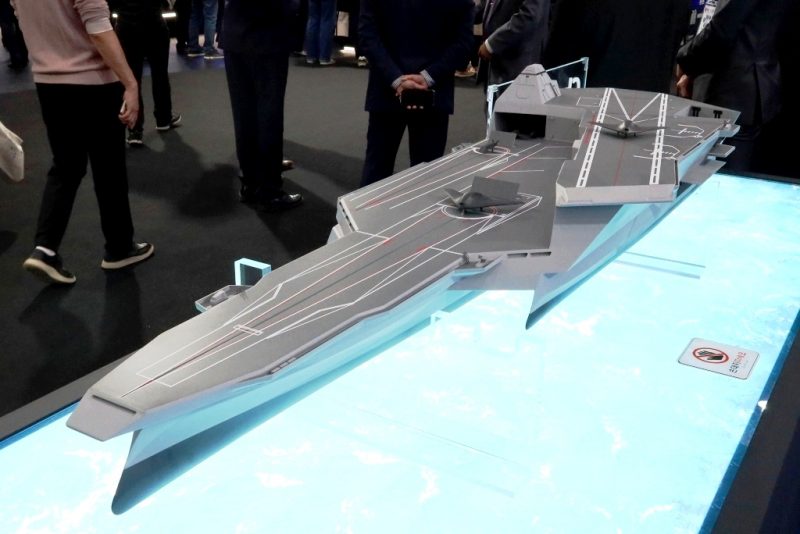
ADEX 2023 – Hanwha unveils an all-unmanned concept carrier
At adex 2023 hanwha exhibited the model of a concept ship, shown last june at madex, designed as an unmanned carrier, capable to deploy unmanned air, surface and underwater vehicles.
When visiting an Aerospace and Defense Exhibition, the spelling for ADEX, mostly oriented towards aviation and land equipment, writing on naval subjects might seem strange. But what is even stranger is the model exhibited by Hanwha, a futuristic approach to the unmanned naval world.
The “Ghost Commander”, the name says all, is a concept study that gave birth to two ship designs, a bigger one and a smaller one, that in perspective will allow an unmanned ship to deploy air, surface and subsurface unmanned assets to ensure a number of missions without putting at risk human crews.
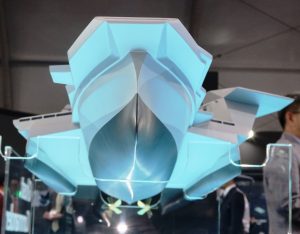
The bigger ship, which eye-catching model was exhibited at the Seoul event, is a 16,000 tonnes hybrid between a battleship and an aircraft carrier, with a length of 200 metres and a maximum speed of 25 knots. The trimaran hull is characterised by an inverted bow, all-electric propulsion being provided electric motors powered by hydrogen fuel cells, a two-pod solution being proposed, each with a five-blade propeller. The main flight deck is coaxial with the hull and runs along the whole ship, a takeoff runway being also coaxial while a second much shorter runway is located starboard, slightly angled to the right. Both are used only for take-off operations, as the stern superstructure does not allow landings. While the longer runway is used to launch bigger UAVs, the starboard one is reserved to smaller airframes.
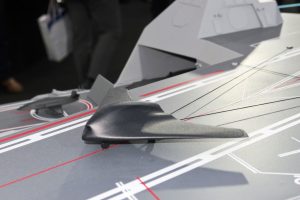
As for landing, a very short runway with arresting cable is located on top of the superstructure, angled left; an elevator on the port side allows to lower the landed UAV in the hangar where a robotic system will allow automatic turnaround operations to get the airframe ready for the next mission. On that same flight deck, on the port side, we could see the landing spots for vertical take-off and landing UAVs.
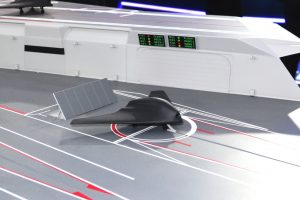
Being a concept ship many solutions might change, however catapult-assisted take off and arresting gear landings seem to be the current choice, although much will depend on UAV performances. Six long-range reconnaissance UAVs with a nearly fly wing configuration are hosted o the ship, the same number of shorter rage airframes being also embarked. For offensive and defensive purposes a total of 48 vertically launched systems, with a mix of loitering munitions and antidrone UAVs, compete the flight detachment.
Transversally to the ship, a rail system allows to carry unmanned surface vessels (USV) at the launch station, where a sort of cage takes the system and lowers it at sea. Two types of USV will be embarked, six specialised in reconnaissance missions, six other being multipurpose boats. No more details were available on USVs.
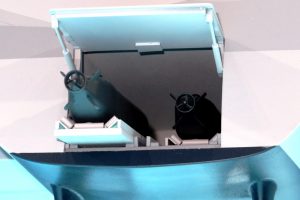
Another rail allows bringing astern unmanned underwater vehicles (UUV) to be launched. The ship hosts eight surveillance UUVs, also defined MRXUUVs, MR standing for multirole as they are reconfigurable according to the mission, that can be anti submarine warfare (ASuW) or mine warfare (MIW). Around 24 metres long, with a 3.0 metres diameter, it has a weight of around 50 tonnes. Propulsion is provided by a fuel cell air independent propulsion system and a lithium ion battery pack that powers the electric motor activating a ducted blade propeller that ensures an 8 knots maximum speed. It is fitted with flank array sonars and with a forward looking sonar. Free flooded rings complete its sensors suite, while a mine module allows it to be used for offensive or defensive mine operations. The MRXUUV is fitted with a hoistable mast that carries electro-optic sensors and antennas for surface and satellite communications.
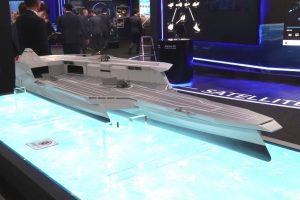
The ship also hosts three Combat XLLUVs. Its dimensions and weight are not very dissimilar from those of the MRXUUV, with a 2.5 metres diameter and a 23 metres length, weight remaining the same at 50 tonnes; only the maximum speed is considerably higher, up to 15 knots. Its stealth characteristics are improved thank to the low noise propeller, a minimal magnetic signature and the strict control on underwater radiated noise. It can be fitted with flank array sonar and multiple aperture sonar and can be armed with torpedoes and mines. It can be equipped with a mast dedicated to a LEO ( Low Earth Orbit ) satellite antenna as well as with a second mast for other equipment, for example electro-optic, both being foldable. The Combat XLLUV can be tasked for numerous missions, antisubmarine, antisurface, mine warfare as well as counter-mine operations.
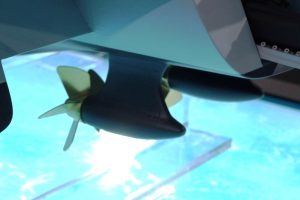
The smaller ship part of the Ghost Commander concept is also based on a trimaran hull and has a 5,000 tonnes displacement, is 130 metres long and can reach 25 knots, the propulsion plant remaining similar athough with a lesser power. Due to the central superstructure it has only a stern flight deck and therefore can only operate vertical take-off and landing UAVs. The ship carries four such UAVs, while a 24 cell system allows the vertical launch of loitering munitions and antidrone UAVs, half the load of the bigger ship. As for USVs and UUVs, the smaller ship capacity is for six each of the multirole assets. According to images provided in a presentation, the 5,000 tonnes ship will also be armed with a gun.
EDR On-Line understood that although the final target is to have a fully unmanned solution, intermediate steps might see the presence of a much reduced crew, awaiting some technologies to be fully developed. As for the timetable, a first prototype is foreseen in 10-15 years. And it might look pretty different from the model seen at ADEX, as concept studies tend to evolve pretty quickly.
Photos by P. Valpolini
- ← ADEX 2023 – Hyundai Rotem unveils its N-WAV 8×8 IFV prototype
- ADEX 2023 – KAI unveils its Combat Collaborative System →
Related posts

The “Berezhok” combat module will supplement the means of combating USVs "> The “Berezhok” combat module will supplement the means of combating USVs
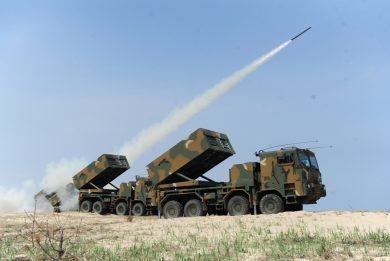
Hanwha signs contract to supply 288 Chunmoo Multiple Rocket Launcher Systems to Poland
► hanwha defence australia, hanwha aerospace and advanced navigation sign mou to propel military navigation technology forward "> ► hanwha defence australia, hanwha aerospace and advanced navigation sign mou to propel military navigation technology forward.
To revisit this article, visit My Profile, then View saved stories .
- The Big Story
- 2024 Election
- Newsletters
- Steven Levy's Plaintext Column
- WIRED Classics from the Archive
- WIRED Insider
- WIRED Consulting
Navy's Trimaran Fighter Speeds Ahead

With the world's largest and most powerful fleet of aircraft carriers, destroyers and cruisers, the U.S. Navy absolutely dominates the deep water. But not so much in shallow waters -- the so-called "littoral zones." Close to land, a ship might face overwhelming numbers of shore-based guns and missiles, swarms of small attack boats, plus the occasional hull-destroying coral reef. It's far too dangerous for a $2-billion destroyer, to say nothing of a $10-billion carrier.
The Navy's solution is to build lots of smaller, cheaper ships. The heart of this effort is the 3,000-ton-displacement "Littoral Combat Ship." LCS adapts commercial yacht and ferry designs -- then adds weapons, sensors, and robots. When the ship was conceived in 2004, each copy was supposed to cost just $220 million -- and the Navy wanted to build the first 13 by 2009. But after years of design changes and botched contracts , only two LCSs have been finished, each at a cost of over $600 million.
It's been rough sailing for the Navy's inshore fighter. But there might be smoother waters ahead.
The second LCS, and the first built to General Dynamics triple-hull "trimaran" ferry design, has spent this month on builder's trials on the Gulf of Mexico. " I am hearing nothing but good news from every possible place” about LCS-2 Independence , Galrahn wrote. This in contrast to Lockheed Martin's LCS-1 Freedom , a modified yacht that proved a real gas guzzler on her own trials last year.
The U.S. Navy still plans on buying at least 55 of the fast, coast-hugging LCSs, despite the cost over-runs and technical glitches on the first batch of vessels. The Navy has learned from Freedom and Independence , and costs should come down, according to Adm. Gary Roughead, the sea service's top officer. " We've turned the corner ," Roughead said.
Navy support for the LCS is undiminished, according to one officer working on the Navy portions of the forthcoming Quadrennial Defense Review, the Pentagon's mega-strategy document. The officer, who requested anonymity, said the inshore ship is "the only way the Navy gets bigger." Navy planners still hope to expand the fleet from today's 280 combat vessels, to as many as 313.
The Navy's love for LCS does not extend to other small vessels that could help the sea service in the littorals, however. According to our source, the sea service is only grudgingly accepting the shallow-water catamaran transports that Secretary of Defense Robert Gates endorsed in his April speech announcing major shifts in weapons investment.
As for new versions of the coastal patrol boats and river craft that have proved so useful in Iraq? "I believe in the end we will see these vessels built as an outcome of QDR deliberations, but the Navy will state that they were forced upon them, and attempt to ignore them," the officer said. He added that the Navy might consign all future small ships to the "purgatory" that is the Navy's new Expeditionary Combat Command -- the same command that oversees Navy construction workers and port security guards.
[PHOTO: General Dynamics]
- Rosy Future for Navy's Troubled Shoreline Fighters?
- Littoral Combat Ship Sets Sail
- Navy Chief Smacks Lockheed, Cancels LCS
- U.S. Scraps Shoreline Fighter; Israel Ponies Up
- Gates: Why I Kept Troubled Ship, Swimming Vehicle
- Shoreline Fighter's Slick Showoff
- Navy Already Shifting Away from Shallow Waters?


IMAGES
VIDEO
COMMENTS
Naval Group’s “Ocean Avenger” Drone Carrier Warship is a trimaran design that carries a 155mm gun and several banks of VLS tubes. The three hulls allow for two straight runways and a rotorcraft spot at the stern. Half the displacement of the BAE UXV, the “Ocean Avenger” lacks a floodable well deck.
Helicopter facilities and the mission bay dominate the stern of the Independence class. The design for Independence is based on a high-speed trimaran (Benchijigua Express) hull built by Austal (Henderson, Australia). The 418-foot (127 m) surface combatant design requires a crew of 43 sailors.
The 40,000 ton Stealth Trimaran Aircraft Carrier (STAC) could operate an air wing of up to 55 aircraft using both ski-jump for STOVL aircraft and 450ft (140m) long diagonal deck for launching CTOL aircraft.
China Shipbuilding Trading Company plans for a high-tech trimaran warship with all-electric propulsion, multiple helicopters, and deadly missiles. Read on.
Because catamarans don't make a ton of sense for aircraft carriers. The advantage to a catamaran is that you can achieve very high fineness ratio without sacrificing stability, by splitting your displacement into two narrow hulls connected by a common beam.
Impossible Engineering | Thursdays at 9/8cThe new Littoral Combat Ships like the USS Independence use a trimaran design for greater speed, agility, and stabi...
The other UCL design studies, ranging from an offshore patrol vessel to a small aircraft carrier, are outlined. The various naval architectural considerations of powering, stability, structures and manoeuvring are then described.
A new aircraft carrier, currently under construction in Shanghai, is the most visible sign of China's rapidly expanding navy. It is larger than China's current two carriers and differs in key aspects. But the natural comparison is to the U.S. Navy's latest carriers, the Ford Class.
Hanwha exhibited the model of a concept ship designed as an unmanned carrier, capable to deploy unmanned air, surface and underwater vehicles
Navy's Trimaran Fighter Speeds Ahead. With the world’s largest and most powerful fleet of aircraft carriers, destroyers and cruisers, the U.S. Navy absolutely dominates the deep water. But not so...